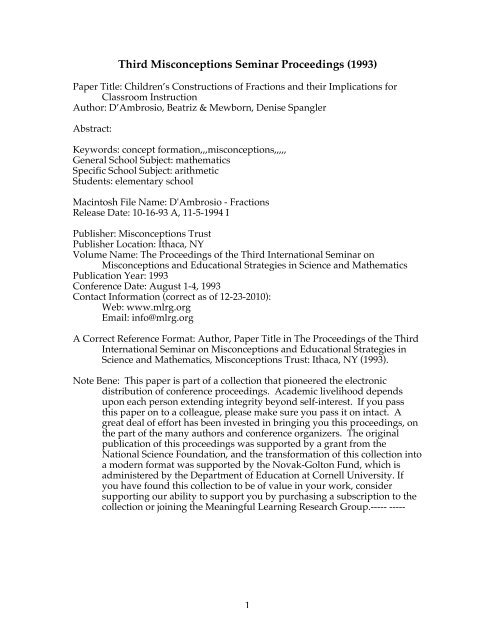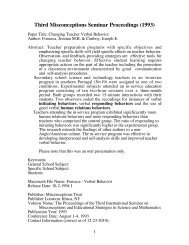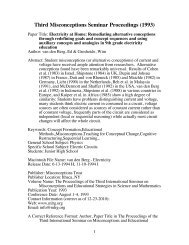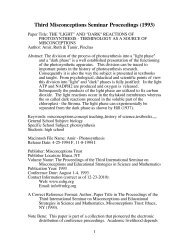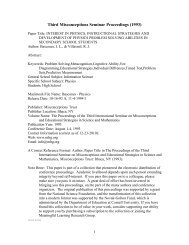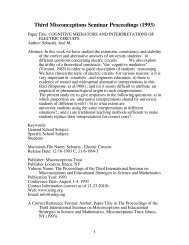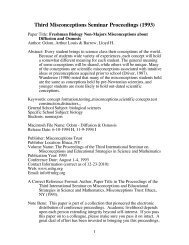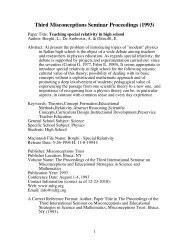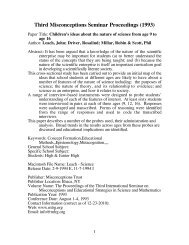Children's Constructions of Fractions and their Implications for
Children's Constructions of Fractions and their Implications for
Children's Constructions of Fractions and their Implications for
You also want an ePaper? Increase the reach of your titles
YUMPU automatically turns print PDFs into web optimized ePapers that Google loves.
Third Misconceptions Seminar Proceedings (1993)<br />
Paper Title: Children’s <strong>Constructions</strong> <strong>of</strong> <strong>Fractions</strong> <strong>and</strong> <strong>their</strong> <strong>Implications</strong> <strong>for</strong><br />
Classroom Instruction<br />
Author: D’Ambrosio, Beatriz & Mewborn, Denise Spangler<br />
Abstract:<br />
Keywords: concept <strong>for</strong>mation,,,misconceptions,,,,,<br />
General School Subject: mathematics<br />
Specific School Subject: arithmetic<br />
Students: elementary school<br />
Macintosh File Name: D'Ambrosio - <strong>Fractions</strong><br />
Release Date: 10-16-93 A, 11-5-1994 I<br />
Publisher: Misconceptions Trust<br />
Publisher Location: Ithaca, NY<br />
Volume Name: The Proceedings <strong>of</strong> the Third International Seminar on<br />
Misconceptions <strong>and</strong> Educational Strategies in Science <strong>and</strong> Mathematics<br />
Publication Year: 1993<br />
Conference Date: August 1-4, 1993<br />
Contact In<strong>for</strong>mation (correct as <strong>of</strong> 12-23-2010):<br />
Web: www.mlrg.org<br />
Email: info@mlrg.org<br />
A Correct Reference Format: Author, Paper Title in The Proceedings <strong>of</strong> the Third<br />
International Seminar on Misconceptions <strong>and</strong> Educational Strategies in<br />
Science <strong>and</strong> Mathematics, Misconceptions Trust: Ithaca, NY (1993).<br />
Note Bene: This paper is part <strong>of</strong> a collection that pioneered the electronic<br />
distribution <strong>of</strong> conference proceedings. Academic livelihood depends<br />
upon each person extending integrity beyond self-interest. If you pass<br />
this paper on to a colleague, please make sure you pass it on intact. A<br />
great deal <strong>of</strong> ef<strong>for</strong>t has been invested in bringing you this proceedings, on<br />
the part <strong>of</strong> the many authors <strong>and</strong> conference organizers. The original<br />
publication <strong>of</strong> this proceedings was supported by a grant from the<br />
National Science Foundation, <strong>and</strong> the trans<strong>for</strong>mation <strong>of</strong> this collection into<br />
a modern <strong>for</strong>mat was supported by the Novak-Golton Fund, which is<br />
administered by the Department <strong>of</strong> Education at Cornell University. If<br />
you have found this collection to be <strong>of</strong> value in your work, consider<br />
supporting our ability to support you by purchasing a subscription to the<br />
collection or joining the Meaningful Learning Research Group.----- -----<br />
1
Children’s <strong>Constructions</strong> <strong>of</strong> <strong>Fractions</strong> <strong>and</strong> <strong>their</strong><br />
<strong>Implications</strong> <strong>for</strong> Classroom Instruction 1<br />
Beatriz D’Ambrosio, The University <strong>of</strong> Georgia, USA<br />
Denise Spangler Mewborn, The University <strong>of</strong> Georgia, USA<br />
Researchers at The University <strong>of</strong> Georgia have been studying children’s<br />
constructions <strong>of</strong> fraction schemes <strong>for</strong> three years as part <strong>of</strong> a project funded by<br />
the National Science Foundation. The NSF project, titled Children’s Construction<br />
<strong>of</strong> the Rational Numbers <strong>of</strong> Arithmetic, involves a teaching experiment (see<br />
Steffe & Cobb, 1983 <strong>for</strong> a complete description) in which one teacher, generally a<br />
university faculty member or graduate student, works with two children in the<br />
environment <strong>of</strong> a computer microworld. Members <strong>of</strong> the NSF project staff have<br />
designed three computer microworlds <strong>for</strong> use in the project using Object Logo.<br />
One <strong>of</strong> the microworlds is called TOYS <strong>and</strong> involves the manipulation <strong>of</strong> various<br />
discrete objects. Another microworld, STICKS, allows the children to manipulate<br />
line segments, thus providing experiences with linear continuous units. The<br />
third microworld is called CANDYBAR <strong>and</strong> involves the manipulation <strong>of</strong><br />
rectangular regions, or two-dimensional continuous units. (See Biddlecomb &<br />
Whitmire, 1992 <strong>for</strong> a more complete description <strong>of</strong> the microworlds.)<br />
The same thirteen children are being followed through <strong>their</strong> third, fourth,<br />
<strong>and</strong> fifth grade years. We began to collaborate with <strong>their</strong> classroom teachers<br />
during the winter <strong>of</strong> <strong>their</strong> fourth grade year. Our primary purpose <strong>for</strong> initiating<br />
this collaboration was to explore ways <strong>of</strong> adapting NSF project findings to a<br />
whole class situation. There were many facets to the adaptation, including<br />
working with a class <strong>of</strong> 25 students <strong>of</strong> varying abilities instead <strong>of</strong> two students <strong>of</strong><br />
matched ability, changing computer activities into activities without a computer,<br />
dealing with the limitations <strong>of</strong> physical materials <strong>and</strong> <strong>their</strong> accompanying<br />
classroom management problems, contending with district <strong>and</strong> teacher<br />
objectives <strong>for</strong> content coverage <strong>and</strong> assessment, <strong>and</strong> trying to be loyal to a<br />
constructivist philosophy <strong>of</strong> teaching within the constraints <strong>of</strong> a traditional<br />
classroom.<br />
We began our experience by meeting with the three fourth grade teachers<br />
several weeks be<strong>for</strong>e they were scheduled to begin teaching the fractions<br />
chapters in <strong>their</strong> textbook. We discussed the teachers’ objectives <strong>and</strong> concerns<br />
2
<strong>for</strong> the unit, <strong>and</strong> we shared with them some <strong>of</strong> our experiences <strong>and</strong> observations<br />
in the NSF project. We <strong>of</strong>fered to assist the teachers in teaching the fractions unit<br />
in any way they wished, from observing, to providing manipulatives, to<br />
providing computer assistance, to teaching a few lessons. We were careful to<br />
emphasize that we did not want to take over <strong>their</strong> classrooms <strong>and</strong> teach the<br />
entire unit because we did not want to convey the idea that we knew how to<br />
teach the unit “correctly” <strong>and</strong> they did not. Each teacher had access to a<br />
Macintosh computer with the three microworlds on its hard drive, but the<br />
teachers had virtually no experience with these microworlds.<br />
One teacher, Mrs. Watson, was particularly interested in having us in her<br />
classroom on a daily basis to observe her lessons, interact with the children, work<br />
with the children in small groups on the computer, co-plan lessons, <strong>and</strong> teach<br />
lessons. One or the other <strong>of</strong> the authors (<strong>and</strong> sometimes both) was present in<br />
Mrs. Watson’s classroom every day <strong>for</strong> approximately three weeks.<br />
In this paper, we will relate our experiences in Mrs. Watson’s classroom.<br />
We will first identify specific findings that have emerged from the NSF project<br />
<strong>and</strong> describe how we attempted to address these findings in our work in the<br />
classroom. We will then discuss the children’s constructions <strong>of</strong> fraction concepts<br />
that we anticipated seeing <strong>and</strong> the constructions we saw that we did not<br />
anticipate. We will also describe activities that were used in the classroom in an<br />
attempt to address students’ limited constructions <strong>of</strong> fractions. These activities<br />
were <strong>of</strong>ten adaptations <strong>of</strong> activities used in the NSF project in the computer<br />
microworld environment. We will describe our attempts to design suitable <strong>of</strong>fcomputer<br />
activities <strong>and</strong> our struggles to align NSF project objectives <strong>and</strong><br />
classroom teachers’ objectives through computer <strong>and</strong> computerless activities.<br />
NSF PROJECT FINDINGS<br />
Iteration <strong>of</strong> the unit. After working with children <strong>for</strong> one <strong>and</strong> one-half<br />
years using the TOYS <strong>and</strong> STICKS microworlds, the NSF project staff had<br />
developed a set <strong>of</strong> working hypotheses about how children might be helped to<br />
make more powerful constructions <strong>of</strong> fraction concepts. Some <strong>of</strong> these<br />
hypotheses were in the <strong>for</strong>m <strong>of</strong> suggestions <strong>for</strong> approaches to teaching fraction<br />
concepts, <strong>and</strong> others were in the <strong>for</strong>m <strong>of</strong> statements about limiting constructions<br />
they had seen children develop. We tried to take these hypotheses into account<br />
3
when designing activities <strong>for</strong> classroom use, but as we will discuss later in the<br />
paper, the hypotheses did not always translate neatly into classroom activities.<br />
The fundamental hypothesis <strong>of</strong> the NSF project staff was that children<br />
need to construct a definition <strong>of</strong> a unit fraction as an iterable unit which can be<br />
used to reproduce the whole or to produce any other fraction with that<br />
denominator. For example, a robust definition <strong>of</strong> 1/3 would be that 1/3 is that<br />
quantity which can be iterated three times to produce the unit. In addition, it is<br />
crucial to recognize that 1/3 can be iterated n times to produce n/3, even if n > 3.<br />
This contrasts sharply with the traditional textbook definition <strong>of</strong> 1/3 as one out<br />
<strong>of</strong> three equal pieces.<br />
In the NSF project setting, children were introduced to fractions in the<br />
linear, continuous microworld <strong>of</strong> STICKS. As an introductory activity, children<br />
were given a stick <strong>and</strong> asked to mark where half <strong>of</strong> the stick would be <strong>and</strong> then<br />
determine whether or not they had found half <strong>of</strong> the stick. Children <strong>of</strong>ten used a<br />
strategy <strong>of</strong> comparing the two pieces <strong>of</strong> the stick to determine if they were equal.<br />
When the same problem was posed with marking 1/3 <strong>of</strong> the stick, the<br />
comparison strategy was no longer efficient. Children were then constrained to<br />
use an iterative strategy in which they copied the piece they had identified as 1/3<br />
two times <strong>and</strong> checked to see if the stick joined with its copies was the same<br />
length as the original stick. Children later used this iterative strategy to make<br />
fractions such as 2/3 <strong>and</strong> 7/3.<br />
Whole numbers to fractions. Closely related to the notion <strong>of</strong> a unit<br />
fraction as an iterable unit is the NSF project staff’s hypothesis that children’s<br />
constructions <strong>of</strong> fraction concepts should emerge from <strong>their</strong> constructions <strong>of</strong><br />
whole numbers. Steffe (1992) has identified a variety <strong>of</strong> types <strong>of</strong> number<br />
sequences that children might construct. He states that children who have<br />
constructed a connected number sequence <strong>for</strong> whole numbers recognize one as<br />
an iterable unit which can be iterated to obtain any other whole number. Thus,<br />
the NSF project staff engaged children in fractional activities which had <strong>their</strong><br />
basis in the children’s whole number knowledge. For example, in the STICKS<br />
microworld children constructed a “staircase” <strong>of</strong> sticks ranging from a stick <strong>of</strong><br />
length one (which was arbitrarily drawn) to a stick <strong>of</strong> length 12. Students were<br />
then asked three types <strong>of</strong> questions: Which stick would result if the 6-stick was<br />
4
epeated seven times? How many 8-sticks would be needed to make a 24-stick?<br />
Which stick could you repeat four times to make a 28-stick? Students could<br />
answer these questions using <strong>their</strong> knowledge <strong>of</strong> whole number addition,<br />
multiplication <strong>and</strong> division facts, <strong>and</strong> they checked <strong>their</strong> results by iterating the<br />
appropriate stick the correct number <strong>of</strong> times to produce the desired result. NSF<br />
project staff members then introduced fraction language into the activity by<br />
noting that since an 8-stick could be repeated three times to make a 24-stick, an 8-<br />
stick is 1/3 <strong>of</strong> a 24-stick.<br />
Traditional algorithms <strong>for</strong> finding equivalent fractions, simplifying<br />
fractions, comparing <strong>and</strong> ordering fractions, <strong>and</strong> per<strong>for</strong>ming operations with<br />
fractions rely heavily on children’s facility with basic facts involving whole<br />
numbers. However, in our experience we were more interested in helping<br />
children use <strong>their</strong> whole number knowledge to develop meaning <strong>for</strong> fractional<br />
concepts than <strong>for</strong> per<strong>for</strong>ming algorithms.<br />
Linear models. Traditional textbooks <strong>and</strong> classroom practices make<br />
minimal use <strong>of</strong> a linear model <strong>for</strong> fractions. Their use is generally limited to<br />
using a number line to compare fractions. However, in the NSF project, children<br />
spent the first year working with the discrete TOYS microworld <strong>and</strong> the second<br />
year working with the linear STICKS microworld. In <strong>their</strong> third year, the children<br />
will begin to work with the area microworld, CANDYBAR. The reasoning behind<br />
this sequencing <strong>of</strong> experiences was that linear models help children construct<br />
rich definitions <strong>of</strong> fractions without becoming dependent on the “number <strong>of</strong><br />
parts shaded out <strong>of</strong> total number <strong>of</strong> parts” view <strong>of</strong> fractions typically af<strong>for</strong>ded by<br />
the area model. In our experience, we engaged the children in activities<br />
involving discrete, linear <strong>and</strong> area models <strong>for</strong> fractions, <strong>and</strong> we placed particular<br />
emphasis on activities involving folding strips <strong>of</strong> paper <strong>and</strong> making number<br />
lines to familiarize them with a linear model <strong>for</strong> fractions.<br />
Estimation <strong>and</strong> power <strong>of</strong> visual representations. As children in the NSF<br />
project worked with the computer microworlds, it became apparent that they<br />
were empowered by the dynamic visual representations af<strong>for</strong>ded by the<br />
microworlds. Having the capacity to copy, join, cut, erase, <strong>and</strong> mark objects<br />
instantaneously proved to be a powerful <strong>and</strong> liberating experience <strong>for</strong> the<br />
children. They were able to engage in estimating, predicting, testing, <strong>and</strong><br />
5
evising without any threat <strong>of</strong> the permanence <strong>of</strong> <strong>their</strong> actions. Further, since the<br />
microworlds are devoid <strong>of</strong> any numerical data unless requested by the user, the<br />
children were able to rely heavily on visual estimates, which seemed to<br />
strengthen <strong>their</strong> concept <strong>of</strong> fractional quantities.<br />
In designing classroom activities, we were limited by the availability <strong>of</strong><br />
computer equipment, so we tried to simulate computer activities with concrete<br />
manipulatives such as paper strips, pattern blocks, <strong>and</strong> M & M’s. We quickly<br />
discovered that these physical materials have limitations which make it<br />
impossible to replicate computer experiences. Thus, we began to work with the<br />
children in groups <strong>of</strong> five to eight in the hallway with the computer to af<strong>for</strong>d<br />
them some <strong>of</strong> the same experiences that children were having in the NSF project.<br />
SOURCES OF STUDENTS’ LIMITING CONSTRUCTIONS<br />
Based on the findings <strong>of</strong> the NSF project, the findings <strong>of</strong> other research<br />
projects, <strong>and</strong> our own classroom experiences, we anticipated that fourth graders<br />
would have constructions about fractions that would limit <strong>their</strong> further<br />
underst<strong>and</strong>ings. We have intentionally avoided labeling the children’s<br />
constructions as misconceptions because we believe it is important to view<br />
children’s constructions as objects <strong>for</strong> study which can provide insight into <strong>and</strong><br />
new underst<strong>and</strong>ing <strong>of</strong> <strong>their</strong> thinking. We felt that it was important to take<br />
children’s constructions into consideration when planning classroom activities,<br />
so we endeavored to design activities, both with <strong>and</strong> without the computer, to<br />
explore <strong>and</strong> challenge the children’s constructions. In doing so, we uncovered<br />
children’s constructions that we did not anticipate.<br />
We will begin our discussion by summarizing some <strong>of</strong> the children’s<br />
constructions about fractions <strong>and</strong> speculating about how they may have<br />
emerged. Then we will describe classroom activities which we designed to<br />
extend <strong>and</strong> modify the children’s constructions. We will detail how these<br />
activities were actually implemented in the classroom <strong>and</strong> what new<br />
constructions emerged.<br />
Some <strong>of</strong> the constructions about fractions that we anticipated were the<br />
following: numerators <strong>and</strong> denominators are viewed independently in making<br />
meanings <strong>for</strong> fractions; counting is a fool-pro<strong>of</strong> method <strong>for</strong> determining<br />
6
fractional amounts; “equal” parts are parts that look identical to each other;<br />
there is no connection between division <strong>and</strong> fractional representations <strong>of</strong><br />
quantities. We have sorted these constructions by what we speculate to be <strong>their</strong><br />
potential sources. These sources include the language <strong>of</strong> instruction; the visual<br />
representations used, including the types <strong>of</strong> examples <strong>and</strong> non-examples used;<br />
<strong>and</strong> the textbook sequencing <strong>of</strong> topics. Taken together, these components<br />
roughly describe the children’s prior experiences with fractions.<br />
Language <strong>of</strong> Instruction. As early as first grade, children are presented<br />
with examples that lead them to construct a definition <strong>of</strong> a fraction as number<br />
composed <strong>of</strong> a numerator <strong>and</strong> a denominator which represent different<br />
quantities that can be determined by counting. Children <strong>of</strong>ten see little<br />
relationship between the numerator <strong>and</strong> denominator in a fraction<br />
representation <strong>of</strong> a quantity. The definition “number <strong>of</strong> parts shaded/number <strong>of</strong><br />
equal parts in which the shape was subdivided” only begins to have meaning to<br />
children as they look at examples <strong>and</strong> work on several exercises that rein<strong>for</strong>ce<br />
the “definition” used in the book. Most <strong>of</strong> the examples used in early work with<br />
fractions suggest to children that a fraction is merely the result <strong>of</strong> two counting<br />
experiences reported in a special <strong>for</strong>mat.<br />
Another aspect <strong>of</strong> the language <strong>of</strong> instruction that seems to influence<br />
children’s constructions is related to <strong>their</strong> interpretation <strong>of</strong> the term “fair.” The<br />
notion <strong>of</strong> fair shares, <strong>of</strong>ten used to describe <strong>and</strong> discuss fractional<br />
representations, may have different meanings <strong>for</strong> the child <strong>and</strong> the teacher.<br />
Although used by the teacher to emphasize equality in partitioning, children’s<br />
real world experiences seem to interfere with this interpretation. NSF project<br />
staff members routinely used the phrase “mark this stick in three pieces so that<br />
the shares are fair” with children to indicate that the stick was to be divided into<br />
three congruent pieces. The word “fair” was generally substituted <strong>for</strong> “equal” or<br />
“congruent” throughout NSF project teaching sessions, but it became apparent<br />
that the children’s meaning <strong>of</strong> “fair” was not the same as the teacher’s.<br />
Presumably based on <strong>their</strong> real world experiences, children seemed to define<br />
“fair” as “everybody gets a piece <strong>of</strong> approximately the same size.” This was<br />
particularly true when the children were partitioning representations <strong>of</strong> food<br />
items. It seemed natural to them to divide the items into “fair enough” shares.<br />
The word “fair” did not carry the connotation <strong>of</strong> precision or equality that it<br />
7
carried <strong>for</strong> the adults. The notion <strong>of</strong> sharing apparently did not correspond to<br />
children’s prior work with partitive division either.<br />
Also related to the language <strong>of</strong> instruction are the difficulties students<br />
seem to have with the notion <strong>of</strong> what constitutes the whole in different problems<br />
or experiences. During instruction, teachers <strong>of</strong>ten take <strong>for</strong> granted that the whole<br />
in consideration is obvious. Little time is spent discussing how fractional<br />
representations <strong>for</strong> the same figures might differ if the whole was defined in<br />
different ways. For example, when asked to shade one fifth <strong>of</strong> the objects below<br />
(Figure 1), children may wonder what constitutes the whole.<br />
Figure 1<br />
It is not unusual <strong>for</strong> children to partition the objects into sets <strong>of</strong> five <strong>and</strong> shade<br />
one in each set. Although three objects will be shaded in the end, this may be an<br />
indication that the children are struggling to accept the entire set as a whole.<br />
Visual representations. Much <strong>of</strong> children’s early work with fractions<br />
leads them to a stongly held construction that “equal” means “look alike.” There<br />
are few examples used in children’s early work with fractions that would falsify<br />
this belief. In fact, most non-examples <strong>of</strong> the belief are used as non-examples <strong>of</strong><br />
fractional representations, which serves to rein<strong>for</strong>ce <strong>their</strong> belief. Rarely will a<br />
child be asked to reason whether the figure below (Figure 2) would represent a<br />
whole sectioned into fourths.<br />
Figure 2<br />
Even discrete models are usually drawn with multiple pictures <strong>of</strong> identical<br />
objects. The discussion about whether the size <strong>of</strong> these objects is important is<br />
8
never raised. In fact, in one textbook series analyzed, the question is trivialized<br />
by a definition <strong>of</strong> fractional representations that states that the child should be<br />
concerned with the size <strong>of</strong> the parts only when dealing with the area model.<br />
In examining textbooks it is interesting to note that half <strong>of</strong> a figure is<br />
almost always represented by shapes that are cut into two parts or a number <strong>of</strong><br />
parts that represents a multiple <strong>of</strong> two, <strong>and</strong> half <strong>of</strong> those parts are shaded.<br />
Rarely will a child be asked to identify what fractional part <strong>of</strong> the figure below<br />
(Figure 3) is shaded. Note that in this figure there are three component parts,<br />
<strong>and</strong> yet the shaded region is in fact one-half <strong>of</strong> the total figure. The mere<br />
existence <strong>of</strong> three parts would be a distracter <strong>for</strong> many children <strong>and</strong>, based on<br />
<strong>their</strong> constructions, most children would conclude that the shaded part could not<br />
be represented by a fraction, especially not a fraction where the denominator is<br />
two.<br />
Figure 3<br />
Another common construction by the children, that we speculate<br />
originates from the types <strong>of</strong> pictorial examples used in the textbooks <strong>and</strong> lessons,<br />
is in <strong>their</strong> underst<strong>and</strong>ing that sections shaded should be adjacent to each other.<br />
Although many children would recognize two-sixths as shaded in Figure 4, it is<br />
not unusual <strong>for</strong> children not to recognize two-sixths as shaded in Figure 5.<br />
Figure 4 Figure 5<br />
Textbook sequencing. In order to underst<strong>and</strong> the nuances involved in<br />
pictorial representations <strong>of</strong> fractional quantities, children need a thorough<br />
underst<strong>and</strong>ing <strong>of</strong> area <strong>and</strong> equivalence <strong>of</strong> area. Connections to other areas <strong>of</strong> the<br />
9
mathematics curriculum are also crucial to developing a rich underst<strong>and</strong>ing <strong>of</strong><br />
fractions. For example, linking work with fractions to linear measurement can<br />
aid children in learning concepts, such as the iterative unit, <strong>and</strong> skills, such as the<br />
juxtaposition <strong>of</strong> units to measure a segment. Un<strong>for</strong>tunately, the mathematics<br />
curriculum is <strong>of</strong>ten presented in a compartmentalized fashion so that children do<br />
not have the opportunity to construct connections between various topics, such<br />
as fractions <strong>and</strong> geometry <strong>and</strong> measurement. Typically, chapters on geometry<br />
<strong>and</strong> measurement are placed later in textbooks than the fractions chapters. Even<br />
when these chapters appear earlier in the book, they tend to be skipped <strong>and</strong><br />
“saved” <strong>for</strong> after achievement testing.<br />
Another troublesome aspect <strong>of</strong> textbook treatment <strong>of</strong> fractions is the<br />
omission <strong>of</strong> experiences with the number line model. In one textbook series the<br />
number line is mentioned <strong>for</strong> the first time in the fourth grade book, <strong>and</strong> then<br />
only briefly in discussing comparison <strong>of</strong> fractions. Interestingly, the NSF project<br />
has found the linear model to be quite effective in children’s construction <strong>of</strong><br />
fractional concepts, especially in the use <strong>of</strong> the unit fraction as an iterative unit<br />
that can be used repeatedly in order to build the whole. The linear model tends<br />
to de-emphasize the need <strong>for</strong> underst<strong>and</strong>ing relationships <strong>of</strong> area as children are<br />
striving to make sense <strong>of</strong> fractional constructs.<br />
ACTIVITIES<br />
Classroom activities were designed with the a<strong>for</strong>ementioned<br />
constructions <strong>and</strong> sources <strong>of</strong> limiting constructions in mind. The first set <strong>of</strong><br />
activities involved experiences with pattern blocks. The intent <strong>of</strong> these activities<br />
was to provide children with experiences that would help them construct<br />
meaning <strong>for</strong> the concept <strong>of</strong> “equal parts” embedded in the typical definition <strong>of</strong><br />
fractions used in textbooks. Since the children had not had recent experiences<br />
with notions <strong>of</strong> equivalence <strong>of</strong> area, we did not want to assume that they could<br />
draw on that construction <strong>for</strong> underst<strong>and</strong>ing fractional representations <strong>of</strong> shaded<br />
regions. We hoped that through our interactions with the children during the<br />
activities we would come to better underst<strong>and</strong> <strong>their</strong> constructions <strong>of</strong> equivalence<br />
<strong>of</strong> area.<br />
In <strong>their</strong> initial work with pattern blocks, the children were asked to fill<br />
certain regions with the blocks. Each region was then considered the whole, <strong>and</strong><br />
10
the blocks were used to describe different fractional parts <strong>of</strong> that whole. The<br />
emphasis <strong>of</strong> the discussion on the first day <strong>of</strong> instruction was on the number <strong>of</strong><br />
different ways <strong>of</strong> filling the outlines <strong>of</strong> the shapes. Children counted the shapes<br />
needed to fill the outline <strong>and</strong> reported with whole number descriptions. For<br />
example, to fill a region in the shape <strong>of</strong> a hexagon the children reported the<br />
following:<br />
C1: I used two reds.<br />
C2: One red, three greens.<br />
C3: Six greens.<br />
C4: One red, one blue, one green.<br />
The chance to introduce alternative language involving fractional terminology<br />
<strong>for</strong> these experiences was missed. However, in analyzing this episode we came<br />
to realize how the use <strong>of</strong> the fractional language <strong>for</strong> these examples conflicted<br />
with the teacher’s view <strong>of</strong> how fractional language should emerge. Typically,<br />
she would have used examples in which the numerator would clearly indicate<br />
“the number <strong>of</strong> parts shaded” <strong>and</strong> the denominator would indicate “the total<br />
number <strong>of</strong> parts in which the shape was divided.” This definition was only<br />
directly applicable when pattern blocks <strong>of</strong> one color were used.<br />
Just a few days later the following question was asked <strong>of</strong> the children:<br />
T: Who can explain the meaning <strong>of</strong> 4/5?<br />
C1: Its like a pie divided in five pieces.<br />
T: How many pieces would you have?<br />
C1: 4<br />
T: Good, four-fifths means you would have four pieces out <strong>of</strong><br />
five.<br />
This “review” reflects the limited view <strong>of</strong> the use <strong>of</strong> fractional language as a<br />
means <strong>of</strong> representation that was portrayed to the children. This is especially<br />
worrisome considering that it followed work with pattern blocks in which 1/2<br />
had been represented in numerous ways, many <strong>of</strong> which included more than 2<br />
pieces. The opportunity to probe <strong>for</strong> children’s constructions <strong>and</strong> try to<br />
underst<strong>and</strong> <strong>their</strong> perceptions <strong>of</strong> work with those materials was missed. What<br />
might have served as a powerful perturbation <strong>for</strong> a limiting construction was<br />
overlooked.<br />
11
A situation emerged that indicated a conflict between the teacher’s<br />
predetermined conceptions <strong>of</strong> what she was looking <strong>for</strong> <strong>and</strong> the children’s<br />
solutions to the situations posed. Children were asked to share <strong>their</strong> solutions<br />
<strong>for</strong> covering the yellow hexagon from the pattern block set. The following<br />
solutions ( Figure 6 <strong>and</strong> Figure 7) <strong>for</strong> using two blue pieces (parallelograms) <strong>and</strong><br />
two green pieces (triangles) were placed on the overhead projector:<br />
Figure 6 Figure 7<br />
The children were told that these were the same, <strong>and</strong> Figure 7 was<br />
removed from the overhead projector. Here again the opportunity to challenge a<br />
limiting construction was missed. The knowledge that children <strong>of</strong>ten have<br />
difficulty naming fractional parts that are not adjacent would justify a discussion<br />
with the children <strong>of</strong> why the two green pieces in Figure 6 <strong>and</strong> in Figure 7, in both<br />
cases, represented two-sixths <strong>of</strong> the covered shape. This idea was taken <strong>for</strong><br />
granted <strong>and</strong> may have been an important point to pursue.<br />
The second set <strong>of</strong> activities involved work with paper folding. The use <strong>of</strong><br />
paper folding resulted in several interesting observations. Although paper<br />
folding was initially suggested as a means <strong>of</strong> simulating the STICKS microworld,<br />
the limitations <strong>of</strong> the concrete model soon became evident. First, the strips <strong>of</strong><br />
paper were not interpreted by the children as linear models. They had two<br />
dimensions, <strong>and</strong> the children suggested that the strips could have been folded in<br />
another direction.<br />
As the paper folding activities proceeded, it soon became apparent that<br />
the children were <strong>of</strong>ten using additive reasoning skills to predict the number <strong>of</strong><br />
pieces they would find upon opening a repeatedly folded strip. For example,<br />
after folding a strip in half <strong>and</strong> in half again to produce fourths, the children<br />
were asked to predict what would result after another fold. Many <strong>of</strong> the children<br />
predicted that the paper would be divided into sixths rather than eighths. This<br />
12
construction would later greatly limit <strong>their</strong> underst<strong>and</strong>ing <strong>of</strong> equivalent<br />
fractions.<br />
The inaccuracies <strong>of</strong> the folding process severely limited the possibility <strong>of</strong><br />
using the folded piece as an iterative unit to generate the whole. For example,<br />
the children folded the paper in half, half again <strong>and</strong> repeated the process until<br />
they had sixteenths. The question was then, what would be more effective,<br />
unfolding the strip <strong>and</strong> counting the pieces or using the one sixteenth as an<br />
iterative unit to replicate the whole? In an attempt to simulate the STICKS<br />
microworld we decided to try the latter experience. Whereas in the STICKS<br />
microworld the child might estimate a sixteenth <strong>and</strong> make fifteen copies <strong>of</strong> the<br />
estimate resulting in 16 identical pieces, with paper folding this was not possible.<br />
When iterating the sixteenth, the resulting unit was <strong>of</strong>ten larger than the original<br />
strip. Interestingly, this did not generate any perturbation <strong>for</strong> the children,<br />
which led us to realize that many <strong>of</strong> them had apparently not yet constructed the<br />
iterative fraction scheme. Un<strong>for</strong>tunately, the inaccuracy <strong>of</strong> the materials did not<br />
allow the children to engage in activities that would help them construct iterative<br />
fraction schemes <strong>and</strong> unit partitioning schemes (Steffe & Spangler, 1993; Olive,<br />
1993).<br />
The paper folding activity <strong>and</strong> the <strong>for</strong>ms used to record children’s<br />
findings in <strong>their</strong> explorations revealed yet another unanticipated limiting<br />
construction. When unfolding a paper strip <strong>and</strong> identifying the result, the<br />
children were apparently labeling points, as they would on a number line, <strong>and</strong><br />
losing sight <strong>of</strong> the notion that the folded strip represented a fraction <strong>of</strong> the<br />
original strip. The work with paper folding <strong>and</strong> the labeling <strong>of</strong> the parts was<br />
disassociated from the experiences with fractions to that point. For the children<br />
working with the microworld in the NSF project it became clear that any<br />
combination <strong>of</strong> x pieces <strong>of</strong> a certain size (say 1/4) would produce x /4.<br />
However, with the paper folding that construction was not made, <strong>and</strong>, in fact,<br />
the notion <strong>of</strong> parts having to be adjacent to determine a fraction was rein<strong>for</strong>ced.<br />
Throughout the fractions unit, time was provided <strong>for</strong> children to work in<br />
groups <strong>of</strong> four to eight on the computer with the microworlds with one <strong>of</strong> the<br />
researchers present. All <strong>of</strong> the children in the class except one were unfamiliar<br />
with the microworlds. One child in the class was one <strong>of</strong> the subjects <strong>of</strong> the NSF<br />
13
project study, so he had worked with the TOYS <strong>and</strong> STICKS microworlds <strong>for</strong> two<br />
years. Most <strong>of</strong> our work was with the CANDYBAR microworld, which he had not<br />
used. The nature <strong>of</strong> the children’s experiences with the microworld was quite<br />
different from the experiences provided in the NSF project due to the children’s<br />
lack <strong>of</strong> familiarity with the microworlds, the size <strong>of</strong> the groups we worked with,<br />
<strong>and</strong> the time constraints under which we were working.<br />
The children’s tendency to use additive reasoning in multiplicative<br />
situations in paper folding activities was also manifested in computer activities<br />
in the CANDYBAR microworld. When asked how to make a c<strong>and</strong>ybar with 12<br />
pieces, they replied that making six vertical pieces <strong>and</strong> six horizontal pieces<br />
would yield a c<strong>and</strong>ybar with 12 pieces. When they actually per<strong>for</strong>med this<br />
operation in the microworld <strong>and</strong> produced a c<strong>and</strong>ybar with 36 pieces, they were<br />
puzzled. We repeated this activity many times <strong>and</strong> tried to find all possible<br />
ways <strong>of</strong> making a c<strong>and</strong>ybar with 12 pieces.<br />
An activity involving equivalent fractions demonstrated the power <strong>of</strong> the<br />
visual imagery af<strong>for</strong>ded by the microworlds. The children had already had<br />
classroom experiences with paper folding (both strips <strong>and</strong> sheets), pattern<br />
blocks, <strong>and</strong> the pencil <strong>and</strong> paper algorithm <strong>for</strong> finding equivalent fractions when<br />
this activity took place on the computer. The children were asked make a<br />
c<strong>and</strong>ybar with 12 pieces <strong>and</strong> to fill in some <strong>of</strong> the pieces. They were then asked<br />
to give all names <strong>for</strong> the fractional amount they had shaded. At one point, the<br />
computer screen showed a c<strong>and</strong>ybar with six adjacent pieces shaded as shown in<br />
Figure 8. The children immediately said that 6/12 <strong>of</strong> the figure was shaded.<br />
Seconds later someone noted that 1/2 <strong>of</strong> the figure was shaded. Then someone<br />
said that if “you pretend that these lines (the horizontal lines) aren’t there, 2/4 <strong>of</strong><br />
it is shaded” (Figure 9). To demonstrate what this child was thinking, we<br />
constructed a new c<strong>and</strong>ybar <strong>of</strong> the same size with four vertical pieces in it <strong>and</strong><br />
shaded two <strong>of</strong> them (Figure 9). The children were then presented with several<br />
more problems <strong>of</strong> this type, <strong>and</strong> they were able to imagine removing both<br />
horizontal <strong>and</strong> vertical markings to find other names <strong>for</strong> the fractional amount<br />
that was shaded.<br />
14
Figure 8 Figure 9<br />
Later in the same lesson, the children were shown a c<strong>and</strong>ybar with eight<br />
r<strong>and</strong>omly selected pieces shaded (see Figure 10). When asked <strong>for</strong> a name <strong>for</strong> the<br />
fractional amount shaded, the children quickly counted the number <strong>of</strong> shaded<br />
pieces, <strong>and</strong> said 8/12. When asked <strong>for</strong> other names <strong>for</strong> the fractional amount<br />
shaded, the children were silent <strong>for</strong> a while. Then one boy said, “Oh, I know!<br />
It’s 2/3!” He explained that he imagined moving the shaded pieces into a<br />
configuration where they completely filled a row or a column, thus reducing the<br />
problem to an earlier one which we had already solved. Figures 11, 12, <strong>and</strong> 13<br />
show the child’s thinking as he described it.<br />
Figure 10 Figure 11 Figure 12 Figure 13<br />
Throughout the activities posed <strong>for</strong> the children we observed then relying<br />
heavily on <strong>their</strong> counting schemes. To challenge the children’s definition <strong>of</strong> a<br />
fraction as a number which is the result <strong>of</strong> two counting acts, we designed a<br />
computer activity in which they could not count to solve the problem posed. The<br />
children were presented with a c<strong>and</strong>ybar <strong>and</strong> asked to use the shade function <strong>of</strong><br />
the microworld to shade some fraction <strong>of</strong> the bar. The shade function <strong>of</strong> the<br />
microworld works like a window shade; the mouse pointer is placed at the left or<br />
bottom <strong>of</strong> the c<strong>and</strong>ybar, <strong>and</strong> as the mouse is dragged across the screen, a shading<br />
appears. The shade can be pulled completely across the bar <strong>and</strong> can be retracted<br />
without leaving any evidence <strong>of</strong> where it has been. Once a shade is put in place<br />
by releasing the mouse button, it can be moved again by simply holding down<br />
the mouse button <strong>and</strong> dragging the end <strong>of</strong> the shade. This function allows<br />
children to estimate <strong>and</strong> revise <strong>their</strong> estimates without penalty.<br />
15
This activity began with the children shading unit fraction amounts <strong>of</strong> a<br />
given c<strong>and</strong>ybar. The children were able to check <strong>their</strong> estimates by comparing<br />
them with bars already shaded (i.e. 1/4 should have less shaded than 1/3) <strong>and</strong><br />
by having the computer superimpose a partition <strong>of</strong> the bar into the desired<br />
number <strong>of</strong> pieces on top <strong>of</strong> <strong>their</strong> shaded bar. The children were allowed to revise<br />
<strong>their</strong> estimates as many times as they desired.<br />
Throughout this activity, the children demonstrated an underst<strong>and</strong>ing <strong>of</strong><br />
the concept <strong>of</strong> a unit fraction as an iterable unit. When asked to shade 1/4 <strong>of</strong> a<br />
c<strong>and</strong>ybar, many <strong>of</strong> the children would pull the shade to a spot that they thought<br />
might represent 1/4, measure this amount with a thumb <strong>and</strong> index finder, <strong>and</strong><br />
iterate this measurement three more times to see if it filled the whole bar. If not,<br />
they would adjust the shade slightly <strong>and</strong> repeat the process until they were<br />
satisfied with <strong>their</strong> estimates. When asked to shade 3/5 <strong>of</strong> a c<strong>and</strong>ybar, one child<br />
pulled the shade to where she thought 1/5 would be, measured this amount with<br />
her thumb <strong>and</strong> index finder, iterated this measurement two times, <strong>and</strong> pulled the<br />
shade over to the spot marked by her finger.<br />
In the final set <strong>of</strong> classroom activities we used fractional language to<br />
describe sets <strong>of</strong> discrete objects. The first experiences were geared toward using<br />
fractions to describe the nature <strong>of</strong> the class membership. The number <strong>of</strong> males<br />
<strong>and</strong> females was compared <strong>and</strong> represented in fractional language. This was<br />
done exclusively as a counting experience <strong>and</strong> rein<strong>for</strong>ced the use <strong>of</strong> counting<br />
schemes. That activity was followed by describing the contents <strong>of</strong> a bag <strong>of</strong><br />
pattern blocks. Again, this was mostly a counting activity where the children<br />
were reporting that x blocks were yellow, y blocks were red, etc. The teacher<br />
would then reinterpret those numbers in fractional language.<br />
The final activity involved the use <strong>of</strong> M & Ms. First, children were asked<br />
to determine the fractions representing the ratio <strong>of</strong> M & Ms <strong>of</strong> a particular color<br />
to the total number <strong>of</strong> c<strong>and</strong>ies in <strong>their</strong> bags. After reporting the ratios <strong>for</strong> each<br />
color, the children were asked to count out 24 c<strong>and</strong>ies. They were asked to make<br />
three equal groups.<br />
T: What is 1/3 <strong>of</strong> 24?<br />
Several children: 8/24<br />
16
This solution revealed a dimension <strong>of</strong> <strong>their</strong> underst<strong>and</strong>ing that we might have<br />
otherwise overlooked. The logic <strong>of</strong> this response indicates a natural transfer<br />
from one activity to the next. While the group they were describing could be<br />
called one-third, it might also be called eight twenty-fourths. The connection<br />
between finding one-third <strong>of</strong> 24 <strong>and</strong> dividing 24 by three was never made.<br />
Instead the children related <strong>their</strong> actions to that <strong>of</strong> describing one-third using a<br />
different fraction. They were using <strong>their</strong> counting schemes to reinterpret the<br />
name given to the group. The whole number answer the teacher was insisting<br />
upon made no sense to the children whatsoever.<br />
This is perhaps the example which most clearly illustrates the purpose <strong>of</strong> a<br />
teaching experiment in a constructivist framework. The children’s responses<br />
generated a need <strong>for</strong> the teachers to interpret the underlying mathematics that<br />
the children were using. This process <strong>of</strong> searching <strong>for</strong> meaning in the children’s<br />
work led us to reconstruct our own underst<strong>and</strong>ing <strong>of</strong> the underlying<br />
mathematical concepts involved in the activity. In this particular case we were<br />
taken aback when we recognized the children’s struggle to underst<strong>and</strong> the whole<br />
in consideration. The tremendous shift in interpretation <strong>of</strong> what constitutes the<br />
whole was leading to a gap between the teachers’ interpretations <strong>of</strong> the problem<br />
<strong>and</strong> the children’s interpretation. Interestingly, we <strong>of</strong>ten take it <strong>for</strong> granted that<br />
the assumption <strong>of</strong> what constitutes the whole is understood. Up to this point the<br />
children had worked with describing the set by using fractional names <strong>for</strong> the<br />
subsets. Suddenly, they were asked to give a whole number result <strong>for</strong> what<br />
seemed like the very same problem - describing a subset <strong>of</strong> a given set. There<br />
seems to be a paradox - if the set <strong>of</strong> objects is considered the whole, then how can<br />
each individual object be named as a whole?<br />
FINAL DISCUSSION<br />
Two themes have emerged as we have reflected on our experiences in the<br />
classroom. The first deals with children’s constructions <strong>of</strong> fraction schemes, <strong>and</strong><br />
the second deals with what we have learned about the dynamics <strong>of</strong> the teachinglearning<br />
process.<br />
From our constructions <strong>of</strong> children’s fraction schemes, we have been able<br />
to conclude at least four things. First, developing a conceptual underst<strong>and</strong>ing <strong>of</strong><br />
fractions takes time. This is certainly not a startling new finding, but it has<br />
17
strong implications <strong>for</strong> teaching fractions. In a typical classroom, one week is<br />
devoted to the “introductory” chapter on fractions. In our experience nearly<br />
three weeks <strong>of</strong> 45 minute lessons were spent on developing fraction concepts,<br />
<strong>and</strong> yet we only scratched the surface <strong>of</strong> the children’s potential constructions.<br />
We also likely didn’t even begin to uncover all <strong>of</strong> <strong>their</strong> limiting constructions. In<br />
contrast, the children in the NSF project spent an entire year working with the<br />
STICKS microworld <strong>and</strong> introductory fraction concepts.<br />
Uncovering children’s limiting constructions was another learning<br />
experience <strong>for</strong> us as teachers. Several <strong>of</strong> the constructions discussed earlier in<br />
this paper were uncovered quite by accident. A chance comment by a particular<br />
student or an opportune observation <strong>of</strong> a particular student’s work <strong>of</strong>ten<br />
suggested a line <strong>of</strong> questioning to pursue that led to students verbalizing <strong>their</strong><br />
constructions <strong>of</strong> the material being discussed. Allowing children to verbalize<br />
<strong>their</strong> thinking, however painful that may be <strong>for</strong> them, the teacher, <strong>and</strong> the rest <strong>of</strong><br />
the class, provides irreplaceable opportunities to gain insight into students’<br />
thought processes. We were amazed by the number <strong>of</strong> limiting constructions the<br />
children held <strong>and</strong> how <strong>of</strong>ten they were uncovered purely by chance. Our<br />
experience suggests that children potentially hold a large number <strong>of</strong> limiting<br />
constructions about fractions <strong>and</strong> teachers need to make a conscious ef<strong>for</strong>t to<br />
allow children to verbalize <strong>their</strong> thinking rather than “filling in the blanks” <strong>for</strong><br />
them <strong>and</strong> assuming that we know what the child “really means.”<br />
The M & M example discussed earlier showed us that children try very<br />
hard to make sense <strong>of</strong> what goes on during a mathematics lesson, <strong>and</strong> they<br />
impose structure on situations that seem to them to be unstructured. When no<br />
structure is obvious to the children, they tend to overgeneralize or impose the<br />
most recent structure used on the unfamiliar situation. Such was the case with<br />
the M & M activity where the children assumed based on <strong>their</strong> recent experience,<br />
that the answer to the question, “What is 1/3 <strong>of</strong> 24?” must be a fraction. This<br />
experience suggests that children need rich <strong>and</strong> varied environments in which to<br />
construct fraction concepts. This richness <strong>and</strong> variety can come in the <strong>for</strong>m <strong>of</strong><br />
concrete materials, computer access, interesting <strong>and</strong> challenging problems, group<br />
work, whole class discussions, <strong>and</strong> many other <strong>for</strong>ms.<br />
18
In comparing <strong>and</strong> contrasting the experiences <strong>of</strong> children working with<br />
the microworlds <strong>and</strong> the experiences <strong>of</strong> children working with concrete objects<br />
such as paper strips <strong>and</strong> pattern blocks, we have concluded that both types <strong>of</strong><br />
experiences have <strong>their</strong> limitations. Since the microworlds do not pose problems<br />
<strong>for</strong> children, it is crucial (at least in the initial stages) <strong>for</strong> a teacher to be present to<br />
pose problems <strong>and</strong> probe children’s responses. The ideal setting <strong>for</strong> working in a<br />
microworld would be two children <strong>and</strong> one teacher per computer. However,<br />
since present school circumstances do not allow <strong>for</strong> such luxury, children’s<br />
ownership <strong>of</strong> the learning experience is severely limited when they must share<br />
computer time with six or eight other students.<br />
Some <strong>of</strong> the limitations <strong>of</strong> the concrete materials have been alluded to in<br />
previous sections <strong>of</strong> the paper. Many manipulations with concrete materials are<br />
somewhat permanent <strong>and</strong> cannot be easily changed. Other materials invite<br />
errors that may lead to limiting constructions because <strong>of</strong> <strong>their</strong> lack <strong>of</strong> precision.<br />
In retrospect, one <strong>of</strong> the most striking differences between teaching in the<br />
NSF project activities <strong>and</strong> teaching in the classroom setting was in the role <strong>of</strong> the<br />
teacher. Our intention in the NSF project <strong>and</strong> in the activities proposed <strong>for</strong> use in<br />
the classroom was to create a teaching-learning situation in which we would seek<br />
to underst<strong>and</strong> the students’ meaning making from the experiences we invited<br />
them to engage in <strong>and</strong> find ways <strong>of</strong> modifying these meanings when necessary.<br />
Another characteristic <strong>of</strong> such an environment is the nature <strong>of</strong> the<br />
experiences created <strong>for</strong> the students’ involvement. The deemphasis on direct<br />
instruction <strong>and</strong> the greater emphasis on student activity characterized another <strong>of</strong><br />
our goals. We agree with Papert (1990) when he claims that: “Instruction is not<br />
bad but overrated as the locus <strong>for</strong> significant change in education. Better learning<br />
will not come from finding better ways <strong>for</strong> the teacher to instruct but from giving<br />
the learner better opportunities to construct.”<br />
The teachers in the NSF project ask questions that elicit children’s<br />
verbalization <strong>of</strong> constructions or actions upon objects that reflect <strong>their</strong><br />
constructions. The teacher in the classroom elicited responses <strong>of</strong> a very different<br />
nature. Questions were intended to be evaluative in that they indicated<br />
whether she could move on or whether further instruction or practice was<br />
19
needed. There was little attempt to probe <strong>and</strong> underst<strong>and</strong> children’s meanings.<br />
Her purpose <strong>for</strong> working with us was, in fact, to seek better ways <strong>of</strong> instructing<br />
her students.<br />
In conclusion, we feel that substantial work is needed with teachers to<br />
help them reconceptualize <strong>their</strong> roles in the teaching <strong>and</strong> learning process. This<br />
may enable them to teach in a way that leads to greater underst<strong>and</strong>ing <strong>of</strong> how<br />
children construct knowledge, so that they can use that underst<strong>and</strong>ing to<br />
provide experiences that help children interact with <strong>their</strong> world <strong>and</strong> interpret it<br />
using <strong>their</strong> own mathematics <strong>and</strong> the power it carries.<br />
REFERENCES<br />
Biddlecomb, B. D., & Whitmire, B. D. (1992). Microworlds <strong>of</strong> children’s<br />
construction <strong>of</strong> rational numbers <strong>of</strong> arithmetic. The Mathematics Educator,<br />
3 (2), 15-21.<br />
Olive, J. (1993) Children’s construction <strong>of</strong> fractional schemes in computer<br />
microworlds, Part II: Constructing multiplicative operations with<br />
fractions. Paper presented at the Research Presession <strong>of</strong> the Special<br />
Interest Group <strong>for</strong> Research in Mathematics Education, National Council<br />
<strong>of</strong> Teachers <strong>of</strong> Mathematics, 71st. Annual Meeting, Seattle, Washington.<br />
Papert, S. (1990). Introduction. In Harel, I. (Ed.) Constructionist Learning.<br />
Cambridge, MA: Media Laboratory Publication.<br />
Steffe, L. P., & Cobb, P. (1983). The constructivist researcher as teacher <strong>and</strong><br />
model builder. Journal <strong>for</strong> Research in Mathematics Education, 14, 83-94.<br />
Steffe, L. P. <strong>and</strong> Spangler, D. (1993). Children’s construction <strong>of</strong> iterative fraction<br />
schemes. Paper presented at the Research Presession <strong>of</strong> the Special<br />
Interest Group <strong>for</strong> Research in Mathematics Education, National Council<br />
<strong>of</strong> Teachers <strong>of</strong> Mathematics, 71st. Annual Meeting, Seattle, Washington.<br />
Steffe, L.P. & Wiegel, H.G. (1993). Cognitive play <strong>and</strong> mathematical learning in<br />
computer microworlds. Paper presented at the Annual Meeting <strong>of</strong> the<br />
American Educational Research Association, Atlanta, GA.<br />
Steffe, L.P. (1992). Schemes <strong>of</strong> action <strong>and</strong> operation involving composite units.<br />
Learning <strong>and</strong> Individual Differences, 4 (3), 259-309.<br />
20
1 The experience reported in this paper was supported in part by the NSF Project<br />
No. RED-8954678, Children’s Construction <strong>of</strong> the Rational Numbers <strong>of</strong><br />
Arithmetic. All opinions expressed are solely those <strong>of</strong> the authors.<br />
21


